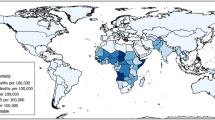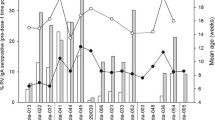Abstract
RotaTeq® is a three-dose, pentavalent, human-bovine reassortment vaccine, indicated for the prevention of rotavirus gastroenteritis (RVGE) in infants aged 6–32 weeks in the EU. The vaccine solution is given orally and can be administered with a number of common childhood vaccines. In the pivotal REST study, RotaTeq® showed high protective efficacy with respect to reductions in the RVGE incidence and associated hospitalizations or emergency department visits. The effectiveness and impact of the vaccine against RVGE-related healthcare use were demonstrated in several real-world studies. RotaTeq® was generally well tolerated, with no or minimal risk of intussusception.
Similar content being viewed by others
Change history
14 March 2018
“Monovalent or combination infant vaccines containing one or more of the following: diphtheria-tetanus-acellular pertussis vaccine, Haemophilus influenzae type b vaccine, inactivated poliovirus vaccine or oral poliovirus vaccine, pneumococcal conjugate vaccine and group C meningococcal conjugate vaccine”
References
Cortese MM, Parashar UD. Prevention of rotavirus gastroenteritis among infants and children: recommendations of the Advisory Committee on Immunization Practices (ACIP). MMWR Recomm Rep. 2009;58(RR-2):1–25.
Vesikari T, Van Damme P, Giaquinto C, et al. European Society for Paediatric Infectious Diseases consensus recommendations for rotavirus vaccination in Europe: update 2014. Pediatr Infect Dis J. 2015;34(6):635–43.
Detailed review paper on rotavirus vaccines. Geneva: World Health Organization; 2009.
Hungerford D, Smith K, Tucker A, et al. Population effectiveness of the pentavalent and monovalent rotavirus vaccines: a systematic review and meta-analysis of observational studies. BMC Infect Dis. 2017;17(1):569.
EuroRotaNet: annual report 2016. European Rotavirus Network; Liverpool; 2017.
Heaton PM, Goveia MG, Miller JM, et al. Development of a pentavalent rotavirus vaccine against prevalent serotypes of rotavirus gastroenteritis. J Infect Dis. 2005;192(Suppl 1):S17–21.
Withdrawal of rotavirus vaccine recommendation. MMWR Morb Mortal Wkly Rep. 1999;48(43):1007.
Rotarix®. EU summary of product characteristics. London: European Medicines Agency; 2017.
RotaTeq®. EU summary of product characteristics. London: European Medicines Agency; 2017.
Liu GF, Hille D, Kaplan SS, et al. Postdose 3 G1 serum neutralizing antibody as correlate of protection for pentavalent rotavirus vaccine. Hum Vaccines Immunother. 2017;13(10):2357–63.
Vesikari T, Matson DO, Dennehy P, et al. Safety and efficacy of a pentavalent human-bovine (WC3) reassortant rotavirus vaccine. N Engl J Med. 2006;354(1):23–33.
Vesikari T, Itzler R, Matson DO, et al. Efficacy of a pentavalent rotavirus vaccine in reducing rotavirus-associated health care utilization across three regions (11 countries). Int J Infect Dis. 2007;11(Suppl 2):S29–35.
McGrath EJ, Thomas R, Duggan C, et al. Pentavalent rotavirus vaccine in infants with surgical gastrointestinal disease. J Pediatr Gastroenterol Nutr. 2014;59(1):44–8.
Tanaka Y, Yokokawa R, Rong HS, et al. Concomitant administration of diphtheria, tetanus, acellular pertussis and inactivated poliovirus vaccine derived from Sabin strains (DTaP-sIPV) with pentavalent rotavirus vaccine in Japanese infants. Hum Vaccines Immunother. 2017;13(6):1–7.
Vesikari T, Karvonen A, Borrow R, et al. Results from a randomized clinical trial of coadministration of RotaTeq, a pentavalent rotavirus vaccine, and NeisVac-C, a meningococcal serogroup C conjugate vaccine. Clin Vaccines Immunol. 2011;18(5):878–84.
Ciarlet M, He S, Lai S, et al. Concomitant use of the 3-dose oral pentavalent rotavirus vaccine with a 3-dose primary vaccination course of a diphtheria-tetanus-acellular pertussis-hepatitis B-inactivated polio-Haemophilus influenzae type b vaccine: immunogenicity and reactogenicity. Pediatr Infect Dis J. 2009;28(3):177–81.
Ciarlet M, Sani-Grosso R, Yuan G, et al. Concomitant use of the oral pentavalent human-bovine reassortant rotavirus vaccine and oral poliovirus vaccine. Pediatr Infect Dis J. 2008;27(10):874–80.
Rodriguez ZM, Goveia MG, Stek JE, et al. Concomitant use of an oral live pentavalent human-bovine reassortant rotavirus vaccine with licensed parenteral pediatric vaccines in the United States. Pediatr Infect Dis J. 2007;26(3):221–7.
Vesikari T, Karvonen A, Ferrante SA, et al. Sustained efficacy of the pentavalent rotavirus vaccine, RV5, up to 3.1 years following the last dose of vaccine. Pediatr Infect Dis J. 2010;29(10):957–63.
Vesikari T, Itzler R, Karvonen A, et al. RotaTeq®, a pentavalent rotavirus vaccine: efficacy and safety among infants in Europe. Vaccine. 2009;28(2):345–51.
Itzler R, Koch G, Matson DO, et al. Robustness of the healthcare utilization results from the Rotavirus Efficacy and Safety Trial (REST) evaluating the human-bovine (WC3) reassortant pentavalent rotavirus vaccine (RV5). BMC Pediatr. 2010;10:42.
Goveia MG, Rodriguez ZM, Dallas MJ, et al. Safety and efficacy of the pentavalent human-bovine (WC3) reassortant rotavirus vaccine in healthy premature infants. Pediatr Infect Dis J. 2007;26(12):1099–104.
Goveia MG, DiNubile MJ, Dallas MJ, et al. Efficacy of pentavalent human-bovine (WC3) reassortant rotavirus vaccine based on breastfeeding frequency. Pediatr Infect Dis J. 2008;27(7):656–8.
Dennehy PH, Vesikari T, Matson DO, et al. Efficacy of the pentavalent rotavirus vaccine, RotaTeq® (RV5), between doses of a 3-dose series and with less than 3 doses (incomplete regimen). Hum Vaccines. 2011;7(5):563–8.
Goveia MG, Suprun L, Itzler RF, et al. Efficacy and safety of pentavalent human-bovine reassortant rotavirus vaccine when administered with greater than 10 weeks between doses. Pediatr Infect Dis J. 2010;29(3):263–5.
Karafillakis E, Hassounah S, Atchison C. Effectiveness and impact of rotavirus vaccines in Europe, 2006–2014. Vaccine. 2015;33(18):2097–107.
Orrico-Sanchez A, Lopez-Lacort M, Perez-Vilar S, et al. Long-term impact of self-financed rotavirus vaccines on rotavirus-associated hospitalizations and costs in the Valencia Region, Spain. BMC Infect Dis. 2017;17(1):267.
Clarke E, Desselberger U. Correlates of protection against human rotavirus disease and the factors influencing protection in low-income settings. Mucosal Immunol. 2015;8(1):1–17.
Vesikari T, Uhari M, Renko M, et al. Impact and effectiveness of RotaTeq® vaccine based on 3 years of surveillance following introduction of a rotavirus immunization program in Finland. Pediatr Infect Dis J. 2013;32(12):1365–73.
Hemming-Harlo M, Vesikari T, Uhari M, et al. Sustained high effectiveness of Rotateq on hospitalizations attributable to rotavirus-associated gastroenteritis during 4 years in Finland. J Pediatric Infect Dis Soc. 2016;6(4):317–23.
Gagneur A, Nowak E, Lemaitre T, et al. Impact of rotavirus vaccination on hospitalizations for rotavirus diarrhea: the IVANHOE study. Vaccine. 2011;29(21):3753–9.
Martinon-Torres F, Bouzon Alejandro M, Redondo Collazo L, et al. Effectiveness of rotavirus vaccination in Spain. Hum Vaccines. 2011;7(7):757–61.
Castilla J, Beristain X, Martinez-Artola V, et al. Effectiveness of rotavirus vaccines in preventing cases and hospitalizations due to rotavirus gastroenteritis in Navarre, Spain. Vaccine. 2012;30(3):539–43.
Immergluck LC, Parker TC, Jain S, et al. Sustained effectiveness of monovalent and pentavalent rotavirus vaccines in children. J Pediatr. 2016;172(116–20):e1.
Staat MA, Payne DC, Donauer S, et al. Effectiveness of pentavalent rotavirus vaccine against severe disease. Pediatrics. 2011;128(2):e267–75.
Payne DC, Selvarangan R, Azimi PH, et al. Long-term consistency in rotavirus vaccine protection: RV5 and RV1 vaccine effectiveness in US children, 2012–2013. Clin Infect Dis. 2015;61(12):1792–9.
Wang FT, Mast TC, Glass RJ, et al. Effectiveness of the pentavalent rotavirus vaccine in preventing gastroenteritis in the United States. Pediatrics. 2010;125(2):e208–13.
Payne DC, Boom JA, Staat MA, et al. Effectiveness of pentavalent and monovalent rotavirus vaccines in concurrent use among US children < 5 years of age, 2009–2011. Clin Infect Dis. 2013;57(1):13–20.
Leino T, Ollgren J, Salo H, et al. First year experience of rotavirus immunisation programme in Finland. Vaccine. 2012;31(1):176–82.
Hemming-Harlo M, Markkula J, Huhti L, et al. Decrease of rotavirus gastroenteritis to a low level without resurgence for five years after universal RotaTeq vaccination in Finland. Pediatr Infect Dis J. 2016;35(12):1304–8.
Roue JM, Nowak E, Le Gal G, et al. Impact of rotavirus vaccine on premature infants. Clin Vaccine Immunol. 2014;21(10):1404–9.
Dennehy PH, Goveia MG, Dallas MJ, et al. The integrated phase III safety profile of the pentavalent human-bovine (WC3) reassortant rotavirus vaccine. Int J Infect Dis. 2007;11(Suppl 2):S36–42.
Belongia EA, Irving SA, Shui IM, et al. Real-time surveillance to assess risk of intussusception and other adverse events after pentavalent, bovine-derived rotavirus vaccine. Pediatr Infect Dis J. 2010;29(1):1–5.
Oberle D, Jenke AC, von Kries R, et al. Rotavirus vaccination: a risk factor for intussusception? Bundesgesundheitsblatt Gesundheitsforschung Gesundheitsschutz. 2014;57(2):234–41.
Monk HM, Motsney AJ, Wade KC. Safety of rotavirus vaccine in the NICU. Pediatrics. 2014;133(6):e1555–60.
Thrall S, Doll MK, Nhan C, et al. Evaluation of pentavalent rotavirus vaccination in neonatal intensive care units. Vaccine. 2015;33(39):5095–102.
Acknowledgements
The manuscript was reviewed by: G. Gabutti, Department of Medical Sciences, University of Ferrara, Ferrara, Italy; A. Orrico-Sánchez, Vaccine Research, Fundación para el Fomento de la Investigación Sanitaria y, Biomédica de la Comunitat Valenciana, FISABIO-Public Health, Valencia, Spain; S. Saluja, Saran Ashram Hospital, Dayalbagh, Agra, India; T. Vesikari, Vaccine Research Centre, University of Tampere Medical School, Tampere, Finland. MSD Vaccins, the marketing-authorization holder of RotaTeq®, was also offered an opportunity to provide a scientific accuracy review of their data. Changes resulting from comments received were made on the basis of scientific and editorial merit.
Author information
Authors and Affiliations
Corresponding author
Ethics declarations
Funding
The preparation of this review was not supported by any external funding.
Conflict of interest
Y.Y. Syed and K.A. Lyseng-Williamson are employees of Adis/Springer, are responsible for the article content and declare no conflicts of interest.
Additional information about this Adis Drug Review can be found here: http://www.medengine.com/Redeem/10B99D706236BB95.
Rights and permissions
About this article
Cite this article
Syed, Y.Y., Lyseng-Williamson, K.A. Pentavalent rotavirus vaccine (RotaTeq®) in the prevention of rotavirus gastroenteritis: a profile of its use in the EU. Drugs Ther Perspect 34, 143–149 (2018). https://doi.org/10.1007/s40267-018-0497-z
Published:
Issue Date:
DOI: https://doi.org/10.1007/s40267-018-0497-z




